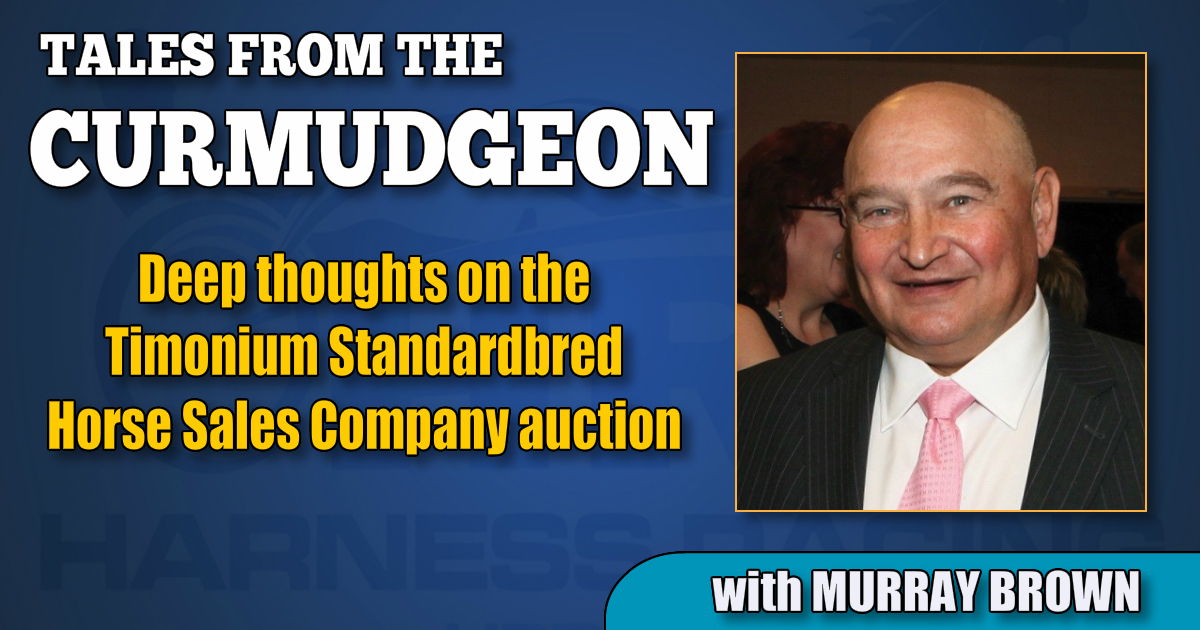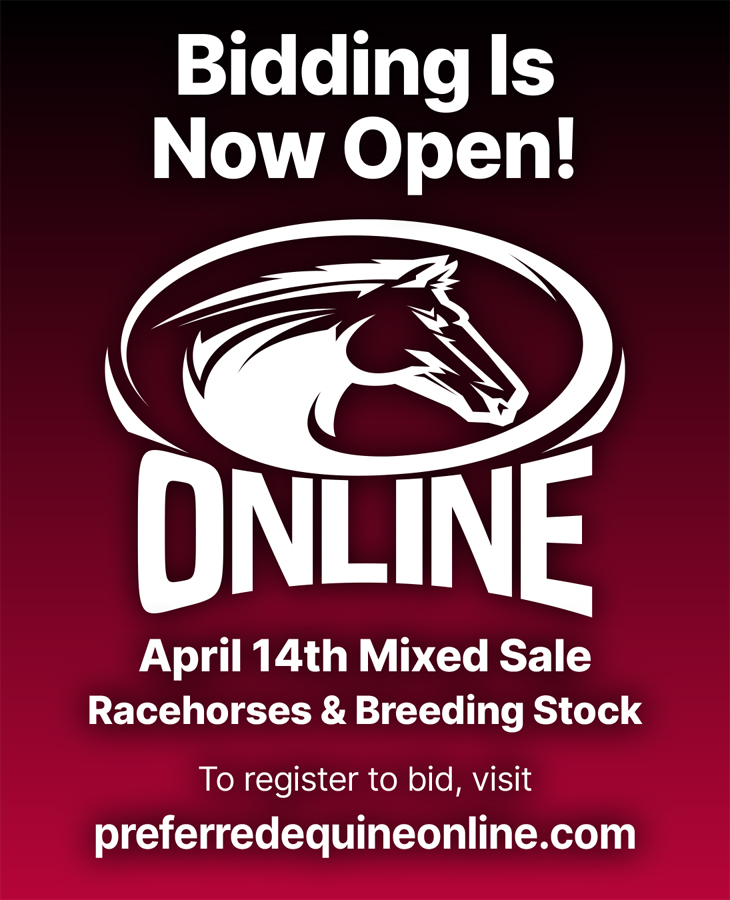Deep thoughts on the Timonium Standardbred Horse Sales Company auction
by Murray Brown
I’m of two separate emotions about this year’s Standardbred Horse Sales Company sale.
The first is of incredible melancholy. It will be the first sale I’ve missed since 1962 — that’s 58 consecutive years.
I know I should not be there, but it still strains at my heart.
Oh the memories! Some of them bad, most of them great.
By this time next year, all of the terrible mess that has been 2020 will have passed and the sale will be back in Harrisburg. Let’s hope so.
Relative to Lexington, there are many reasons why this sale was disappointing — most of them caused by an act of God, otherwise known as COVID-19.
Shall I count the ways.
1. The catalog was down both in quality and in numbers — in my opinion, substantially so. They were missing several long-time consignors some of whom split their consignments. Others, such as Jeff Gural, chose to sell all of his yearlings at Lexington instead of splitting them up.
Let’s start with Day One. Of most note were the omissions of nine yearlings bred by Order By Stables which fled to Lexington because of the movement of the sale from Harrisburg to Timonium. These nine yearlings alone averaged over $175,000 in Lexington.
2. The change in venue. Most people fear change. That, in my opinion, applies doubly to horsepeople. The switch from weatherproof Harrisburg to open air Timonium, was beyond the control of the sales company. They made the best of a bad situation. But Mother Nature dealt them a whammy. The Sunday and Monday leading up to the sale, traditionally the two days when most of the yearlings are shown, were plagued by extreme winds. So much so, that one of the huge tents housing a great number of yearlings collapsed. Much of that occurrence has been covered elsewhere. Suffice to say that it was a near miracle that all horses and people escaped this possible catastrophe without damage. The horse community came together in avoiding what otherwise might have been a calamity.
3. Throughout the sale’s 82-year existence, the vast majority of them have coincided with Election Day. I doubt that it had ever previously affected the success or lack of it of the event. But, 2020 was different for two main reasons. The first is the general nature of this year’s election. It not only created a great divide among Americans, but the sale also started on Election Day itself, where in the past it had begun on the day preceding it. This was for a very good reason, allowing the folks who had been at Hoosier Park over the weekend an extra day to get there and to inspect yearlings. The second reason was the threat of possible violence erupting. Businesses throughout the country were boarding up and numerous people felt there would be rioting, looting and other possible dangers lurking. I know of several people who for this very reason alone did not attend. Our demographic is skewed towards the elderly and many did not want to be exposed to this possible threat.
The counter argument could be made that these same people could have bid and bought from the safety of their home or office using the internet or telephone. Quite a few in fact did.
But there is a great deal to be said for the ability to see and touch the horses upon which you might be bidding. There is also something to be said about the “Mano a Mano” nature of the competition at a horse sale. This causes people to exceed the limits which they had previously established. It’s much easier to restrain oneself sitting behind a computer than it is from the hustle and bustle of the live sale.
To paraphrase my good friend Dave McDuffee, a major purchaser at this sale, “I’ve bought an untold number of yearlings at horse sales for many, many years. Of all the yearlings I’ve bought, I don’t think I’ve ever bought a single one for less than or at the price that I’d established for it.”
4. The difficulty of foreigners, especially Canadians, to get through the borders and to the sale. More than any other sale, this is the one that has been regarded as ‘home” for numerous Canadians. This year, only a negligible number of those usually in attendance were there. Many Canadians and I am told some Europeans tried to attend, but were turned back at the borders.
For some CRAZY and unknown reason, Canadians were fine if they chose to travel by plane. If they were coming by car, it was a totally different story. Some were able to get by the borders.
Others were turned back, sometimes even at the same border and even by the same agent.
I don’t know of a single European buyer who was not already domiciled in the United States, who came over.
The sale usually draws a large contingent from the United Kingdom and Ireland who traditionally have helped the middle and lower segments of the pacing market. They were nowhere to be seen. The absence of members of the Hill and Mounds families was especially noticeable. Scandinavian owners were also noticeable by their absence.
Let’s get down to the sale itself.
THE GOOD
• The top of the market was very good, perhaps even excellent.
The sale’s leading consignor, behemoth Hanover Shoe Farms, appeared to have an excellent sale. I’ll paraphrase the person who I believe to be behind a great part of the success that the Farms has enjoyed for more than the last decade, Dr Bridgette Jablonsky: “The first day was spotty. But the bottom line was excellent. The excellent prices realized at the top more than made up for those that didn’t do as well. Some of the latter probably weren’t Day One yearlings. They would likely have done better on Day Two. Day Two was fantastic. Believe it or not, the average for Day Two was even greater than that for Day Two last year, which was our best ever.”
Hanover has an advantage of course, the chief being that they are by far the sport’s leading breeder. This year, the earnings produced by the Farms are fairly close to an unprecedented DOUBLE that of the next leading breeder.
• The fact that the sale went on at all despite numerous obstacles faced in doing so.
THE BAD
• I’ll begin this by quoting Blue Chip Farms owner Tom Grossman from a post he made on Facebook on Thursday: “It’s very hard to explain the abject pain involved in investing, money and blood, sweat and tears in breeding, raising and prepping a yearling(for sale). Then watching an employee, who cares deeply, walk back from the ring after selling(it) for much less than expected(sometimes less than) the stud fee.”
My response: “Tommy, I’ve been there too many times. After even a good sale I’d get down in the dumps for a few days, because all the yearlings that I spent every single day with for two months were gone — cold turkey. But at least they had sold well and I looked forward to following their training progress. With a bad sale (thankfully there were not too many of those), I’d go into deep depression that might last as much as a few weeks. I knew it was crazy to do so. But I’d blame myself, asking, ‘What could I have done to have made the sale better? I truly believe that it affected me and some of the other employees at the Farms, maybe even more than it affected the owners.”
• With the exception of Hanover, most of the other consignors, especially, but maybe all of the smaller breeders had poor sales. It really hurts me to see this happening.
There are many reasons for it, the chief being the over saturation of a saturated marketplace.
Costs keep rising, yet purses for young horses, especially 2-year-olds, have declined.
The small owner, acting alone, has a very difficult chance in the yearling game.
He or she has few options. They are: Against all odds and all chances of making money, try to go it alone; get in as a part owner in the numerous partnership groups available (my choice); get in the overnight or claiming game (not for me); get out of the business altogether. At 79, I’m still around.
• We are breeding about the same number of horses, but they are better, resulting in the small pie being split thinner.
Racing ownership is not for the faint of heart, especially the yearling end of it, yet speaking for myself, that’s the only route I would even think of following.
• Stallions stay in favor or quickly go out. The top is quite thin. The middle might even be a little thinner. The bottom is terrible. Once a stallion falls out of favor, for all intents and purposes, he has the steepest of roads to overcome before he makes it back. Very few do. This relates to yearling prices. The hot stallion, the small breeder went to when he went to breed his mare, has often turned ice cold when he is selling the yearling produced by that mating.
• With a few exceptions, stud fees need to be lowered to adjust to the needs of the breeders and the buying public. There were more than a few instances where yearlings sold for prices below the stud fee, often well below the stud fee. Most farms have wisely chosen not to announce their 2021 season fees. I’m not a breeder, but I certainly hope for their sakes and the well-being of their customers that they consider this in pricing their horses.
• Syndication prices are too high in the risk/reward ratio, relative to stud fees and yearling prices.. Simply put, they are out of sync with the yearling prices, with a few exceptions that these yearlings can be expected to bring. I guess that I am far too old school in my thinking. I believe that stallions should earn their high stud fees. Of course, I’m probably influenced by the fact that I was at Hanover when outstanding horses such as Super Bowl, Albatross and Western Hanover started off at fees of $5,000, $5,000 and $4,000. They earned their way to the top. Horses starting off at fees over $15,000, if even that high, don’t make a whole lot of sense to me. But I suppose if I was hanged for being sensible, they would be hanging an innocent man.
I’ve purposely tried to leave out names of most breeders or horses for fear of offending some. However I believe those who I am referencing know or should know who they are.
Have a question or comment for The Curmudgeon?
Reach him by email at: hofmurray@aol.com.

















